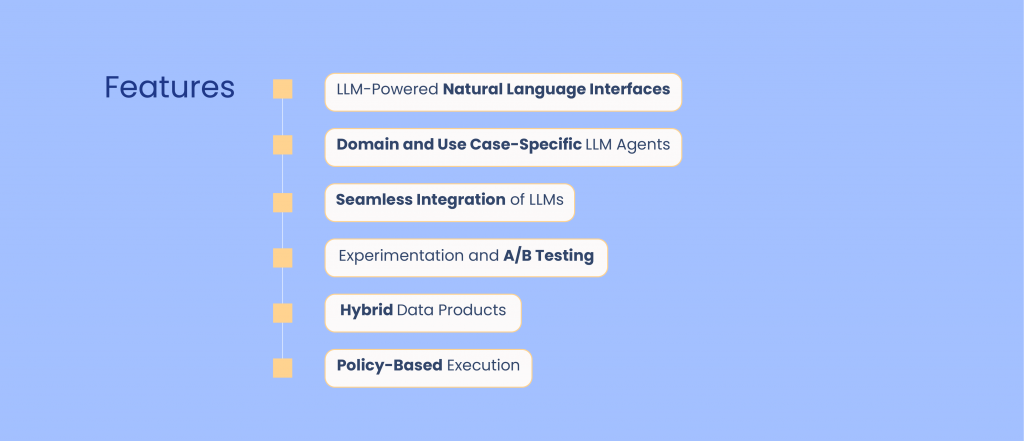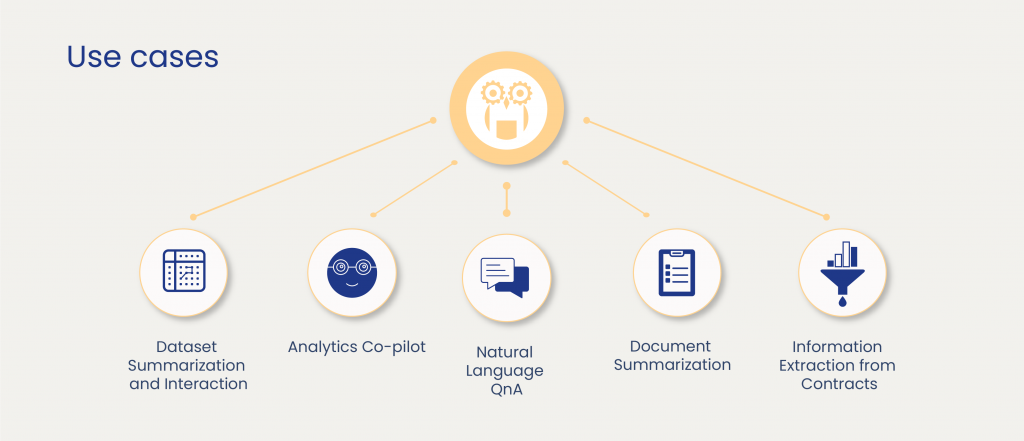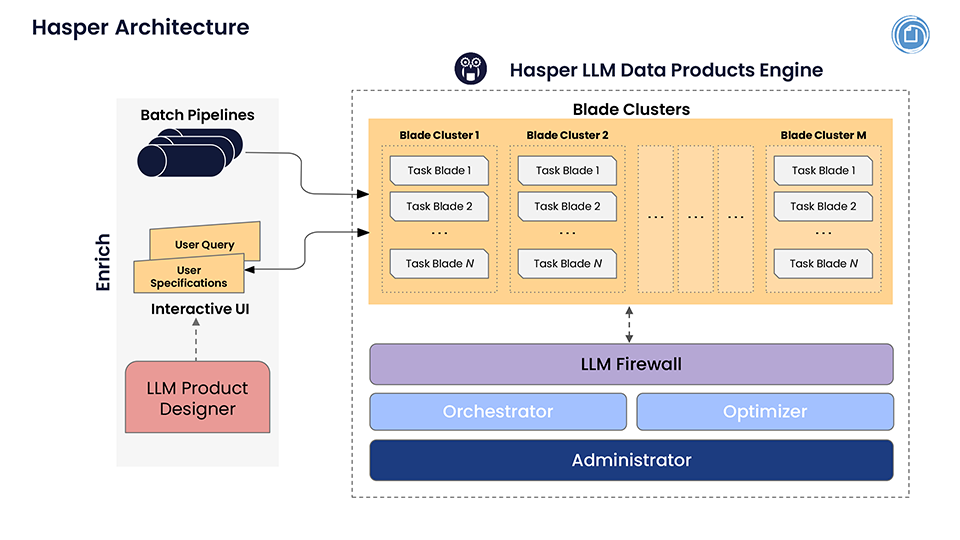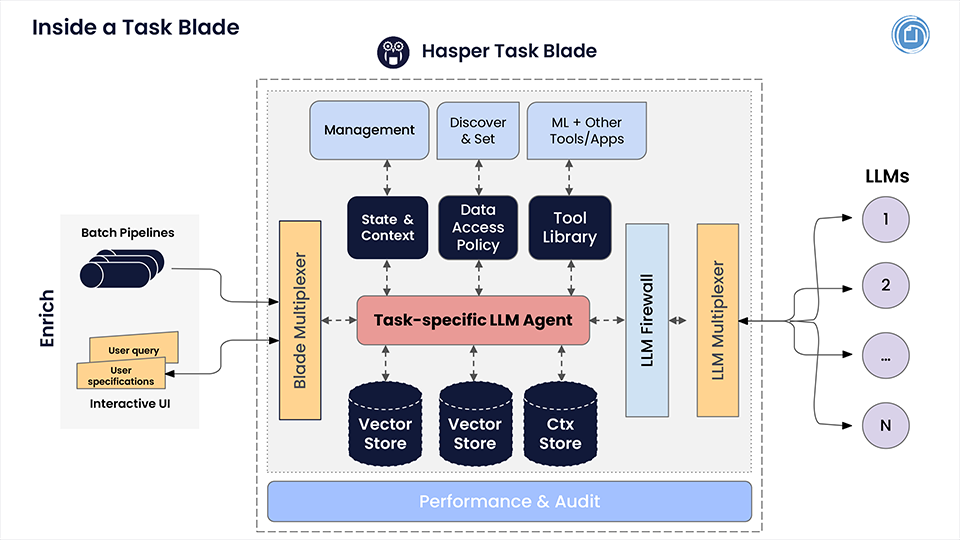Over the last year, we have evolved from an MLops platform company that gave enterprises the ability to build and deploy machine learning for analytics teams, to an applied AI data products platform. Throughout this journey, our mission has remained consistent: to help organizations make better decisions using data. We’ve reached a pivotal moment in that journey today. Generative AI, and in particular, large language models (LLMs) will change the future of work, but there’s a gap between its potential and its actual application within enterprises.
This is a moment when companies that can actually put generative AI to work to build better decision workflows and automate decision-making will surge ahead. On that note, we are thrilled to announce the launch of Hasper, a full-stack LLM data products engine, that enables businesses to rapidly build and productionize customized data products to drive better decisions and business outcomes at the enterprise.
Hasper extends our core product, the Enrich Intelligence platform, which enables data preparation and lightweight ML algorithm execution for advanced analytics data products across a wide variety of use cases. The addition of the Hasper engine transforms Enrich into a full-stack LLM data products platform, unlocking new possibilities and capabilities in fintech, insurance, and e-commerce.
With Hasper, organizations can turn analytics work into data products, where AI creates ready-to-use output or insights, that would have taken analysts, actuaries, and other data teams days or even weeks to put together. The time-to-value on each decision is order-of-magnitude faster than ever, and this creates a serious competitive advantage.
Improving Business Efficiency With Hasper

Hasper enables organizations to use LLMs to solve their custom enterprise business problems with a well-defined ramp-up path. Let’s explore the key features and benefits of Hasper:
LLM-Powered Natural Language Interfaces: Hasper allows business users to interact with data through LLM-powered intelligent natural language interfaces and data products, enabling intuitive user-friendly interactions and seamless workflows.
Seamless Integration of LLMs: Hasper facilitates a smooth integration of LLMs into advanced analytics decision workflows. It enables you to boost the scale of your use cases, the speed of your workflows, and the productivity of your teams using the power of LLMs.
Domain and Use Case-Specific LLM Agents: Hasper enables you to supercharge the LLM that’s most appropriate for each of your use cases by building domain and use case-specific agents, ensuring highly relevant and accurate results tailored to your organization’s unique needs.
Experimentation and A/B Testing: With Hasper, organizations can experiment targeting customers across channels using LLM agents on any number of paths to facilitate continuous improvement. This empowers businesses to refine and optimize their offerings over time, resulting in better outcomes.
Policy-Based Execution: Hasper ensures that your LLM-powered data product operates strictly within best-in-class guardrails. It guarantees compliance with security and privacy policies, safeguarding sensitive data, ensuring safe results, and maintaining regulatory compliance.
Hybrid Data Products: Hasper allows you to build hybrid data products that combine the power of LLMs, machine learning, and traditional analytics. This comprehensive approach enables organizations to effectively address diverse business workflow needs, from data processing to extracting valuable insights and generating intelligent recommendations.
Hasper in Action: Solving Complex Business Challenges with Advanced Analytics

Hasper is a versatile solution that addresses a wide range of use cases across various functions and industries, leveraging the capabilities of LLMs to deliver intelligent data-driven solutions. Here are a few notable examples:
Dataset Summarization and Interaction: Hasper simplifies complex datasets by transforming them into understandable text and generating case-specific recommendations. This enhances data comprehension, facilitates the extraction of actionable insights, and enables businesses to extract the maximum value out of their data.
Analytics Co-pilot: Hasper leverages LLMs’ chain-of-thought reasoning capabilities to construct data-informed responses for users. By semantically understanding the data underlying a business problem, it acts as an expert analytical assistant.
Natural Language QnA: Hasper allows users to span large volumes of text to accurately answer specific questions, that can then be used for everything from pricing a response to a large RFP to helping advise end customers on what insurance or investment policy best meets their needs.
Document Summarization: Hasper streamlines document-heavy use cases like building investor memos, generating qualitative summaries of surveys, and large-scale matching between entities (semantic matching, rather than keyword) such as jobs to CVs, or past legal judgment to new legal advice being sought.
Information Extraction from Contracts: With Hasper, organizations can specify the desired information to be extracted from text-heavy contracts using natural language, eliminating the need for complex coding and manual extraction.
Why does your organization need Hasper?
- LLMs by themselves do not work in an enterprise context; they require a comprehensive solutioning framework.
- The framework provides guardrails and customizability for specific business situations and requirements.
- Effectively utilizing LLMs for analytics use cases requires a well-designed system encompassing architecture, system design, orchestration, and multimodal data science techniques (like ML and NLP).
- Integrating checks for safety, privacy, and compliance with legal requirements and organizational data security and privacy policies are essential.
- Hasper addresses enterprise use cases using LLMs with the appropriate degree of data privacy, security, accuracy, and reliability.
- Hasper protects not just the data and the solution, but also the IP of the enterprise.
Hasper fulfills the need for a robust solutioning framework that accelerates the delivery of LLM-powered analytics data products for enterprises. It addresses the complexities and challenges involved in productionizing a solution around LLMs by providing a ready-to-use framework with out-of-the-box modules that significantly reduce time-to-value and future-proof organizations’ data products.By using Hasper, organizations can focus on delivering value to their businesses without having to build all the supporting infrastructure from scratch.
Behind the Scenes: Exploring the Technology Behind the Intelligent Engine
 At the core of Hasper Engine are task blades, which consist of modules specifically designed for different types of tasks, such as natural language question-answering and summarization. These task blades form blade clusters, with each cluster dedicated to a specific function within an organization. This modular approach simplifies Hasper’s operations and management by handling function-level variations in policies and permissions.
At the core of Hasper Engine are task blades, which consist of modules specifically designed for different types of tasks, such as natural language question-answering and summarization. These task blades form blade clusters, with each cluster dedicated to a specific function within an organization. This modular approach simplifies Hasper’s operations and management by handling function-level variations in policies and permissions.
The Administrator oversees overall system access and control requirements, while the Orchestrator ensures smooth operation by managing configuration and deployment. The Optimizer, in conjunction with the Orchestrator, handles aspects such as availability, reliability, scalability, cost optimization, and overall efficiency of the Hasper Engine.

A task blade comprises various modules, including
LLM Agent: This module wraps around LLM APIs and executes task-specific workflows. It combines grounding, sanitization, prompting techniques, vectorization, optimization, and post-processing to continuously enhance safety, relevance, accuracy, and user experience.
Tool Library: This module serves as a plug-in system to call task-specific tools or third-party applications, providing enhanced functionality to the Hasper ecosystem.
LLM Firewall: The LLM Firewall module enables the configuration of data security and privacy checks before data is directed to an LLM. It ensures compliance with security and privacy policies and allows for independent verification of LLM outputs.
Multiplexer: The Multiplexer module facilitates the automatic selection or switching of LLM backends based on specific task requirements, such as cost, latency, accuracy, efficiency, and provider policy.
State and Context Management: This module provides an operational interface to the LLM Agent for health checking, debugging, and performance monitoring. It tracks and updates LLM Agent states (datasets, users, sessions), configurations, and logs (audits, debugging, etc.) for efficient and holistic management.
Data Access Policy: The Data Access Policy module in Hasper enables organizations to configure user access to datasets, acting as an access control layer. It ensures that only authorized users can interact with datasets in LLM-powered use cases, enhancing data security and governance.
Other Modules: These include interfaces to data product UI and batch pipelines, dataset, and vector database management, and performance monitoring and audits.
Protecting Confidentiality: Security and Privacy Measures
Hasper facilitates a multi-factor control and supervision layer which, when coupled with thorough policy reviews of LLM providers, ensures strong security and adherence to regulatory compliance. Its LLM firewall allows for configuring and enforcing security and privacy policies at the granularity of each use case. Function-wise blade clusters facilitate compliance management at the organizational function level. Not only this, Hasper maintains transparency with audit logs, documentation, and a shared codebase to meet safety, privacy, and legal compliance requirements.
Looking Forward: Hasper’s Roadmap to Innovation
The future roadmap for Hasper includes incorporating accuracy improvements and expanding the solution architecture to handle complex agents. Hasper continues to evolve to meet the growing demands and challenges in the field of advanced analytics, providing organizations with a powerful framework to harness the potential of LLMs and accelerate their analytics journey. With this union between Enrich and Hasper, we hope to unlock new levels of innovation and transformation. This integration will empower organizations to enhance data-driven decision-making by leveraging the power of generative AI and advanced analytics.
For the media announcement click here.



